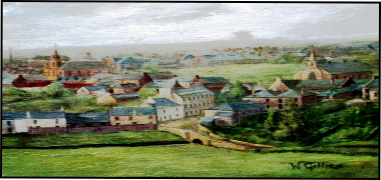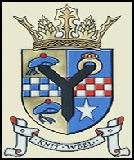Stewarton & District Historical Society Scottish Charitable Incorporated Organisation : SC011194.

Dunlop Street 1970D

Stewarton Viaduct 2008
Coat of Arms reproduced by permission of Stewarton Community Council

Springwell Place 1860

Site produced by
“Davie McKie’s Web Designs.”
Updated
26th January 2024
AGRICULTURE
Stewarton lies in an ideal position for farming,on the gentle sloping banks of the River Annick. Until the 18th century, however, Ayrshire farming followed the rig or strip system (hence the names Rigg Street and Bowes Rigg). If you look carefully at the fields beyond the town and behind the Millhouse Hotel, you can still see the rigs if the sun is in the right position in the sky.
In the later 18th century there were a number of land-
Snodgrass of Cuninghamehead had moved to the country for health reasons, but soon became interested in improving his estate at Cuninghamehead, while William Cuninghame bought Lainshaw Estate, as well as Kirkwood around 1780, but before letting out the lands, he set about improving the land and the tenants' houses.
One way of improving the land was by spreading lime and the remains of lime kilns can still be seen around the town. Another improvement was the introduction of new machinery, and Miller of Wardhead developed an improved plough, which was never patented, while in 1821 it is reported that a ploughing match took place as a result of a wager between McAllister of Kennox and Cuninghame of Lainshaw to see who had the better plough, the result being published in the local papers.
Actual quote from newspaper :-
“On Mr Finlayson's way home, he operated his plough on the lands of William Cuninghame
Esq ., of Lainshaw. Colonel McAllister of Kennox was among the spectators and spoke
of the superior qualities of another plough in the neighbourhood. Mr Finlayson requested
that the matter might be brought to the test by a fair trial and to this the Colonel
frankly agreed, and it was also agreed that it should take place on a piece of rough
ground belonging to himself at 11 o'clock the next day, and that the result should
be published in the county papers -
*Fall = 6 yards imperial measure.
A -

Draffen field looking east towards Little Cutstraw on the Fenwick road.
Riggs
Lime Kiln 1
Lime Kiln 2
Ayrshire dairy cows of James Patrick of Hareshaw Farm. Stewarton. C: 1930

Building Corn stack at Hareshaw.
Wullie Galbraith on steps next to the ladder. c1940

Ian’s A-